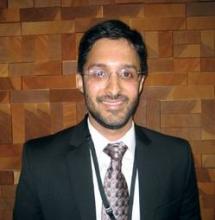VANCOUVER, B.C. – Treatment of electrographic seizures in neonates with hypoxic-ischemic encephalopathy reduces their seizure burden, although the impact on neurodevelopmental outcomes remains unclear, new data show.
Investigators led by Dr. Shamik Trivedi, a neonatology fellow at St. Louis Children’s Hospital, conducted a randomized trial among 69 neonates of at least 36 weeks’ gestational age who had moderate to severe hypoxic-ischemic encephalopathy (HIE).
In half of the neonates, clinicians treated all seizures detected by continuous amplitude-integrated electroencephalographic (EEG) monitoring; in the other half, they treated only those seizures that became clinically apparent.
Results reported in a late-breaker session at the annual meeting of the Pediatric Academic Societies showed that among neonates who did not experience status epilepticus, basing treatment on the EEG rather than on clinical observation yielded a 22% lower burden of electrographic seizures. In addition, the time to seizure treatment was reduced by about half.
The groups did not differ significantly with respect to neurodevelopmental outcomes at 2 years among neonates who had seizures and survived, but the investigators attributed that to the small size of the trial.
"We believe that a multicenter randomized controlled trial with a larger cohort would show a significant difference in neurodevelopmental outcome between the clinical and EEG groups," Dr. Trivedi said.
Fully 60% of seizures in neonates with HIE are subclinical, he noted in an interview. "So a lot of times, babies may be having seizures and you have no idea."
Treatment based solely on clinical observation can result in electromechanical dissociation, whereby seizure activity is no longer clinically evident. "So if you are not seeing any sort of clinical activity of seizures, then you may not have any concern, whereas they could be seizing for a prolonged period of time," he said.
Despite the encouraging results, the findings are too preliminary to warrant a change in practice at this time, according to Dr. Trivedi.
"This was a very important start to this [issue], and hopefully it will stimulate discussion about having a large multicenter clinical trial," session comoderator Dr. Christine A. Gleason, chief of the division of neonatology at Seattle Children’s Hospital, said in an interview. "We all worry about it and we always wonder if some of these little movements are seizures or not. And sometimes, there are no movements, and there it is – it’s a seizure."
Not all neonatology units have the capability for continuous EEG monitoring, she said. "So if it is demonstrated that that can improve the outcome ... then I think that would compel us to think about having additional resources so that we could do continuous monitoring of the EEG for seizures."
In the trial, all of the infants had continuous EEG monitoring for up to 96 hours. In the EEG seizure treatment group, software alerted clinicians of any electrographic seizures, which were treated if confirmed by an epileptologist. In the clinical seizure treatment group, seizures were diagnosed and treated on the basis of clinical observation, except when clinicians had concern about status epilepticus, in which case they had access to a 1-hour EEG.
Overall, 43% of neonates in the EEG seizure treatment group had an electrographic seizure, compared with 59% of neonates in the clinical seizure treatment group.
The former group had a lower electrographic seizure burden (quantified as log units of continuous seizure activity in seconds) among neonates who did not have status epilepticus (6.0 vs. 7.7), fewer electrographic seizure events (7 vs. 12), and a shorter time to seizure treatment (79 vs 170 minutes). There also was a nonsignificantly lower seizure burden in the EEG seizure treatment group among all infants (7.4 vs. 8.4).
The groups were statistically indistinguishable with respect to the rate of death (five total, all among infants with status epilepticus and severe encephalopathy), time to oral feeding in survivors, and durations of mechanical ventilation and hospital stay.
Twenty-four neonates who experienced electrographic seizures survived to follow-up and were evaluated with the Infant and Toddler Development scales of the Bayley-III tool at 18-24 months of age. Within this subset, there was no significant difference in cognitive, motor, or language scores between the EEG and clinical seizure treatment groups. However, in the subset as a whole, higher cumulative seizure burden correlated with significantly poorer scores.
The investigators have not yet looked at the correlation of EEG and clinical seizure events in the trial, according to Dr. Trivedi.
Dr. Trivedi disclosed no relevant conflicts of interest.


